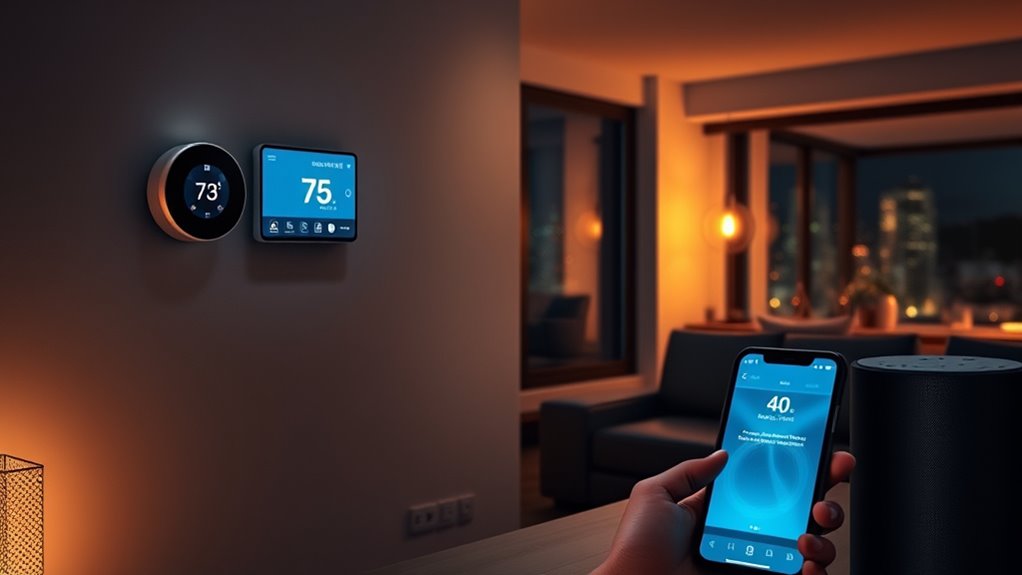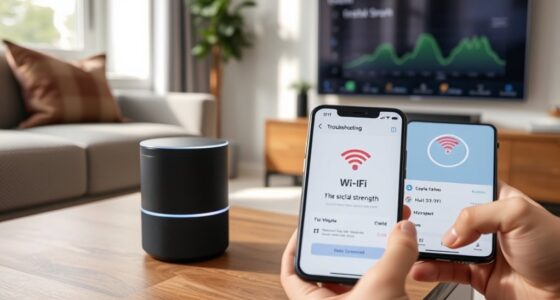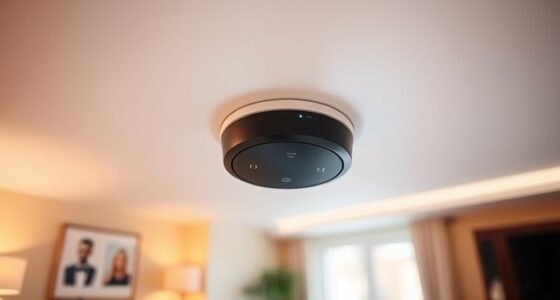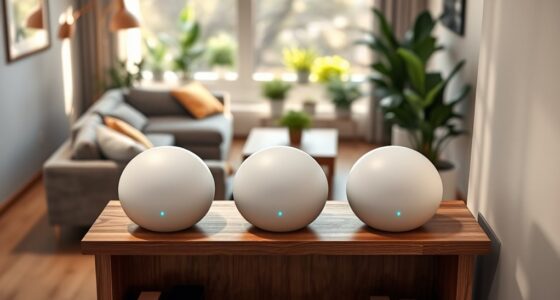When smart home devices act up, start by checking your Wi-Fi signal and moving your router closer or adding extenders if needed. Restart affected devices or hubs to clear glitches. Confirm firmware and apps are up-to-date, and reconfigure voice profiles or retrain voice assistants for better recognition. Reset devices if issues persist. For more troubleshooting tips that can help you restore smooth control, keep exploring these quick fixes.
Key Takeaways
- Verify device compatibility and ensure firmware and app are up-to-date for optimal performance.
- Restart affected devices and routers to clear temporary glitches and restore connectivity.
- Improve Wi-Fi signal strength by relocating the router or using extenders to prevent disconnections.
- Reset voice control devices and retrain voice profiles for accurate recognition and control.
- Remove and re-add devices in the smart home system to fix persistent connectivity or configuration issues.

Smart home technology promises convenience and efficiency, but it’s not immune to glitches that can disrupt your daily routine. One common issue you might face is voice control malfunctioning or becoming unresponsive. If your voice commands aren’t working as expected, the first step is to check your device compatibility. Not all smart devices are compatible with every voice assistant, so ensure that your smart speaker or hub supports the specific devices you’re trying to control. Sometimes, an update might be needed to improve compatibility, so verify whether your firmware or app version is current. If you’ve confirmed compatibility but voice commands still don’t work, try resetting the voice control device. This often involves unplugging it for a few seconds and plugging it back in. Additionally, revisit your voice profile settings to make sure your voice is correctly recognized. Sometimes, retraining the assistant to recognize your voice can resolve recognition issues.
Check device compatibility, update firmware, and retrain voice profiles to fix voice control issues.
Another common glitch relates to device connectivity. Even if your devices are compatible, they may lose connection to your Wi-Fi network or hub. Start by checking your internet connection; a weak or unstable Wi-Fi signal can cause devices to drop offline. Moving your router closer to your smart devices or using a Wi-Fi extender can help stabilize the connection. If your device still isn’t responding, try restarting the device or your smart hub. Often, a quick reset can clear temporary glitches. Also, verify that your app or firmware is up-to-date, as outdated software can cause communication problems. Sometimes, network conflicts or IP address issues interfere with device connectivity. In such cases, renewing your IP lease or resetting your network settings can restore proper communication.
Firmware updates are another key step in fixing glitches. Manufacturers frequently release updates that fix bugs and improve device performance. Check your app for any available updates and install them promptly. Sometimes, a simple restart after updates can resolve lingering issues. If problems persist, removing and re-adding the device to your smart home system can refresh its connection and clear any misconfigurations. Remember to follow the manufacturer’s instructions carefully to avoid further complications. Additionally, understanding the contrast ratio of your projector can significantly improve your viewing experience by delivering deeper blacks and brighter whites, especially in dark scenes.
In essence, most smart home glitches boil down to compatibility issues, connectivity hiccups, or outdated software. Troubleshooting these problems involves a combination of checking device compatibility, ensuring strong Wi-Fi signals, updating firmware, and performing resets. Armed with these quick fixes, you’ll be better equipped to resolve tech troubles promptly and get your smart home running smoothly again.
Frequently Asked Questions
How Can I Prevent Smart Home Glitches From Happening?
To prevent smart home glitches, you should guarantee device compatibility by checking that all gadgets work seamlessly together. Keep your devices updated with the latest firmware and software. Optimize your network by using a strong Wi-Fi signal, reducing interference, and possibly setting up a dedicated network for your smart devices. Regularly reboot your router and devices to maintain smooth operation, minimizing glitches before they happen.
Are There Safety Risks With Smart Home Device Glitches?
You might worry about safety risks with smart home device glitches, but staying proactive helps. When devices malfunction, they could impact device safety or disrupt emergency protocols, like opening doors or turning off alarms. To minimize risks, regularly update firmware, set up backups, and have manual controls. This way, you guarantee your home remains secure and responsive even if glitches occur, keeping your safety a top priority.
What’s the Best Way to Update Smart Home Software?
Your smart home is like a growing garden; regular tending keeps it thriving. To update your device software, start by checking for firmware updates through your app. Make certain your app is compatible with the latest versions, like fitting pieces in a puzzle. Keep your devices connected to Wi-Fi, then follow prompts to install updates. This proactive approach keeps everything running smoothly, avoiding glitches and ensuring your smart home stays in harmony.
Can Smart Home Glitches Affect My Internet Security?
Smart home glitches can indeed impact your internet security. When devices glitch, they may expose vulnerabilities that hackers can exploit, risking your smart home privacy. Device hacking becomes more likely if glitches cause security protocols to fail or if firmware updates are delayed. To protect yourself, regularly update your smart home software, use strong passwords, and monitor device activity. Staying vigilant helps prevent security breaches and keeps your smart home safe.
How Do I Troubleshoot Voice Control Issues?
Voice control issues can feel like talking to a wall sometimes. To troubleshoot, start by checking your device’s microphone and ensuring it’s not muted. Improve voice command accuracy by speaking clearly and directly at the device. If recognition issues persist, restart the device and update its firmware. Make sure your Wi-Fi connection is strong, as poor connectivity can cause delays. These steps can help your smart home listen and respond better.
Conclusion
When your smart home glitches, think of it like a car engine misfiring—sometimes all it takes is a quick reset or a simple check to get everything running smoothly again. Just last week, I fixed my thermostat in minutes, and it felt like rebooting a stubborn computer. Remember, most tech troubles are temporary hiccups, not disasters. With a few quick fixes, you’ll keep your smart home humming along seamlessly, turning chaos into calm in no time.









